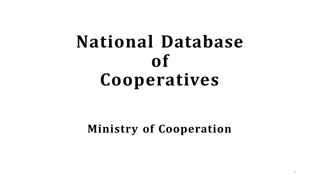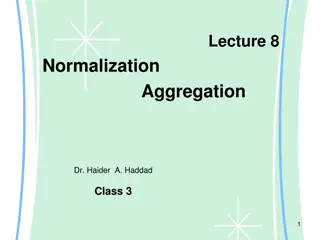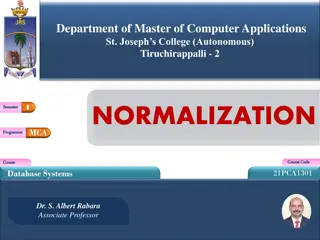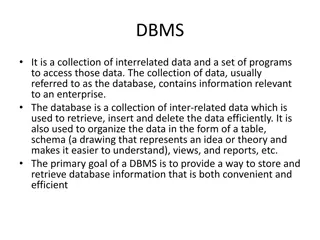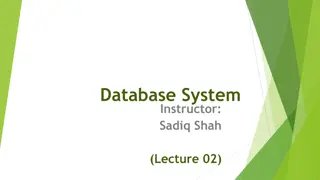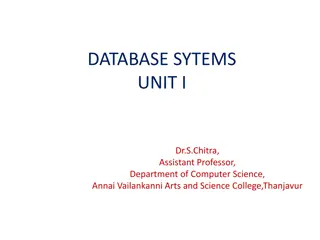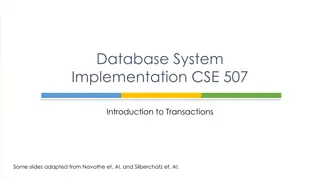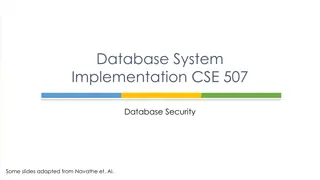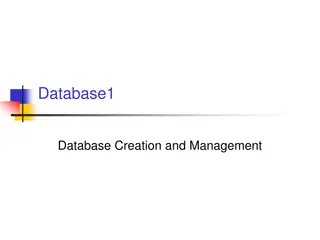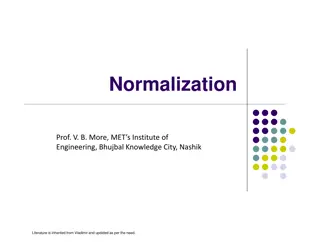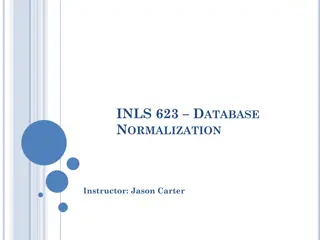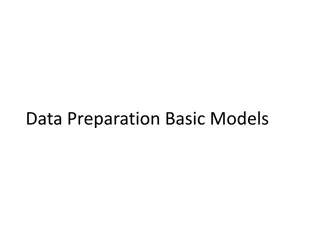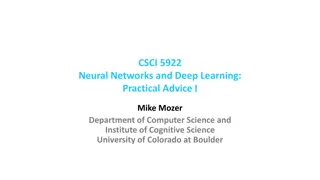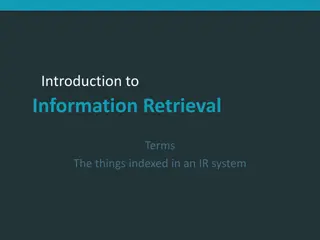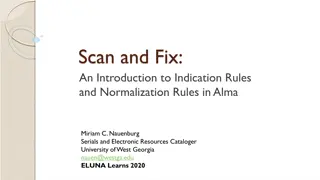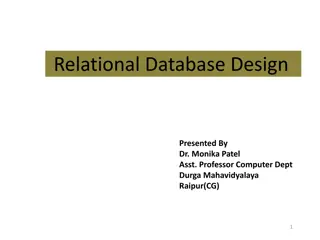Normalisation
Explore databases in detail and understand normalization. Learn how to structure data efficiently in databases for optimal performance. Research and discuss the importance of normalization.
1 views • 20 slides
Building a local facet in Primo VE for Decolonization work
Explore the process of adding publisher/place of publication as a search parameter in Library Search, with insights on using MARC fields, establishing normalization rules, and steps to enable and translate local fields for effective faceted searching in Primo VE. Learn about the nuances of field rec
0 views • 19 slides
fMRI Coregistration and Spatial Normalization Methods
fMRI data analysis involves coregistration and spatial normalization to align functional and structural images, reduce variability, and prepare data for statistical analysis. Coregistration aligns images from different modalities within subjects, while spatial normalization achieves precise anatomic
3 views • 35 slides
Coregistration and Spatial Normalization in fMRI Analysis
Coregistration and Spatial Normalization are essential steps in fMRI data preprocessing to ensure accurate alignment of functional and structural images for further analysis. Coregistration involves aligning images from different modalities within the same individual, while spatial normalization aim
6 views • 42 slides
Understanding Neo4j Graph Database Fundamentals
This comprehensive presentation delves into the fundamentals of Neo4j graph database, covering topics such as the definition of graph databases, reasons for their usage, insights into Neo4j and Cypher, practical applications like data flow analysis, and hands-on instructions on creating and querying
0 views • 20 slides
National Database of Cooperatives: Ministry of Cooperation Initiatives
The Ministry of Cooperation is developing a National Database of Cooperatives to enhance transparency, governance, and policymaking in the cooperative sector. The database aims to provide comprehensive information on cooperatives across sectors, improve coordination among stakeholders, and facilitat
0 views • 22 slides
Database Design Principles and Management Overview
This document presents an overview of database design principles, including structured, semi-structured, and unstructured data types. It delves into the role of Database Management Systems (DBMS) in defining, constructing, manipulating, and sharing databases effectively. It also covers various types
0 views • 47 slides
Introduction to Database Management System Explained
This presentation covers the basics of database management systems, including definitions of data, types of data, structured and unstructured data, storing data in computers using file systems and database systems, and issues with file systems like data redundancy, inconsistency, difficult data acce
1 views • 18 slides
Database Normalization and Aggregation Concepts
Understanding the advantages and disadvantages of database normalization, the concept of aggregation in the ER model, and examples of creating ER diagrams using aggregation rules with related entities. Explore the benefits of smaller databases and better performance through normalization, and how ag
4 views • 11 slides
Understanding Database Normalization and Functional Dependencies
Database normalization is a crucial process that aims to improve database design by organizing data into higher forms of normality. This helps in reducing redundancy and ensuring data integrity. Functional dependencies play a key role in defining relationships between attributes in a database. By un
0 views • 33 slides
Oracle 19c Standard Edition: RAC Migration and Database Solutions Overview
Explore the implications of Oracle Database 19c Standard Edition no longer supporting RAC, and learn about disaster recovery and high availability options for users. Delve into the differences between HA and DR, along with the significance of workload isolation and scalability in database management
3 views • 22 slides
Understanding Database Management Systems (DBMS)
A Database Management System (DBMS) is a crucial tool for organizing, storing, and managing data efficiently. It allows users to create, update, retrieve, and delete data effectively, ensuring data consistency and security. DBMS software like MySQL and Oracle provide interfaces for various database
0 views • 21 slides
Costs and Risks of Implementing a Database Approach
Implementing a database approach involves additional costs and risks that need to be managed effectively. From hiring specialized personnel to dealing with conversion costs and organizational conflicts, organizations must carefully consider the implications of transitioning to a database system. The
0 views • 10 slides
Database Design Process and Concepts
This lecture on designing databases covers the database design process, normalization, transforming E-R diagrams, physical database design concepts, and steps in logical database modeling. It highlights the importance of logical and physical database design in system development, providing insights
0 views • 64 slides
Understanding Entity-Relationship Model in Database Systems
This article explores the Entity-Relationship (ER) model in database systems, covering topics like database design, ER model components, entities, attributes, key attributes, composite attributes, and multivalued attributes. The ER model provides a high-level data model to define data elements and r
0 views • 25 slides
Understanding Database Systems in IT
Database systems play a crucial role in managing and organizing data efficiently. They provide a structured environment for storing and accessing information, enabling various applications in sectors like banking, airlines, universities, sales, and more. The transition from traditional file systems
3 views • 38 slides
Understanding Properties of Database Transactions
Database transactions play a crucial role in ensuring data integrity and consistency within a database system. This content explores the fundamental properties of transactions, such as atomicity, durability, consistency, and isolation. It delves into the requirements and implications of each propert
2 views • 44 slides
Understanding Entity-Relationship Diagrams (ERD) for Database Design
Entity-Relationship Diagrams (ERD) are vital in database design, illustrating entities and their relationships. They help in conceptualizing data models and laying the groundwork for database structures. The process involves identifying entities, defining relationships, and analyzing interactions to
0 views • 40 slides
Database Security Measures and Controls
Database security is crucial to protect against threats like loss of integrity, availability, and confidentiality. Countermeasures such as access control, inference control, flow control, and encryption are important for safeguarding databases. Access control involves creating user accounts and pass
0 views • 35 slides
Performers and Programs Database Webinar - Overview and Features
Learn about the Performers and Programs Database Webinar happening on October 22, 2021. This webinar, presented by Peter Kowalski and introduced by Sharon B. Phillips, offers valuable information about the database's features, including how performers advertise programs, categorization, virtual prog
0 views • 25 slides
Methods of Mark Adjustment in Educational Assessment
In educational assessment, methods like Z-score normalization, quadratic scaling, and piecewise linear scaling are used to adjust marks based on Gaussian distribution assumptions. Z-score normalization helps to adjust both mean and standard deviation, impacting the distribution of marks. Quadratic s
4 views • 25 slides
Overview of Database Systems Architecture and Languages
A database system is essential for storing and managing an organization's data. The architecture includes components like file manager, database manager, and query processor. Additionally, DML and DDL compilers play crucial roles in handling data manipulation and definition tasks. Various data struc
2 views • 28 slides
Understanding Database Normalization Process
Database normalization is a crucial process that helps in organizing data efficiently by reducing redundancy and dependency issues. It involves steps like identifying keys, removing repeating attributes, and transforming data into different normal forms. Each step aims to enhance data integrity and
0 views • 19 slides
Understanding Database Management Systems and Concepts
Explore the world of databases with topics ranging from Database Creation and Management to Basic Database Terms. Learn about the significance of data, information, and metadata in decision-making processes. Discover the purpose of database systems and the role of Database Management Systems (DBMS)
0 views • 25 slides
FlashNormalize: Programming by Examples for Text Normalization
Text normalization is essential for converting non-standard words like numbers, dates, and currencies into consistently formatted variants. FlashNormalize offers a programming-by-examples approach for accurate normalization, addressing challenges posed by traditional manual methods and statistical t
6 views • 14 slides
Understanding Normalization in Database Management
Normalization is a crucial database design technique used to organize tables efficiently, reduce data redundancy, and prevent anomalies in data operations. This process involves decomposing larger tables into smaller, linked tables to ensure consistency and ease of data management.
1 views • 59 slides
Database Normalization: Understanding Sets and Normal Forms
Explore the importance of set theory in database design, learn about different types of sets, subsets, and supersets, understand the basics of normalization techniques to efficiently organize data in databases, and discover the common anomalies associated with unnormalized databases.
0 views • 26 slides
Understanding Data Preparation in Data Science
Data preparation is a crucial step in the data science process, involving tasks such as data integration, cleaning, normalization, and transformation. Data gathered from various sources may have inconsistencies in attribute names and values, requiring uniformity through integration. Cleaning data ad
1 views • 50 slides
Effect of Normalization of Relations with Cuba on Georgia
The normalization of relations with Cuba has had significant effects in Georgia, particularly in terms of diplomatic relations, trade embargo laws, and trade relations. This includes a look at the naming of ambassadors, the importance of diplomatic relations, trade restrictions with various countrie
0 views • 8 slides
Understanding Database Normalization: A Comprehensive Guide
Database normalization is a crucial process in database design to eliminate data redundancy and anomalies. This guide covers the definition of normalization, types of normalization including 1NF, 2NF, and more, along with examples and explanations on achieving each normalization form.
1 views • 22 slides
Understanding Database Normalization Techniques
Database normalization is a crucial technique for organizing data efficiently to eliminate redundancy and anomalies. It involves decomposing tables to ensure data integrity and minimize inconsistencies. Common issues without normalization include excessive memory usage and data manipulation problems
4 views • 21 slides
The World of Azure Database Offerings
Exploring Azure's database offerings including Azure Cosmos DB and Azure SQL Database. Azure Cosmos DB provides a globally scalable document database solution, while Azure SQL Database is a great option for SQL Server workloads. Both platforms offer unique features such as low latency, scalability,
0 views • 15 slides
Best Practices in Neural Network Initialization and Normalization
This resource provides practical advice on input normalization, weight initialization, Xavier normalization, and Glorot/Bengio normalization in neural networks. Tips include the importance of controlling the range of net inputs, setting initial weights appropriately, and understanding the rationale
0 views • 15 slides
Understanding Information Retrieval Techniques
Information retrieval involves various techniques such as stop words exclusion, normalization of terms, language-specific normalization like accents and date forms, and case folding to enhance search efficiency. These methods aim to improve query matching by standardizing and optimizing indexed text
0 views • 9 slides
Understanding Batch Normalization in Neural Networks
Batch Normalization (BN) is a technique used in neural networks to improve training efficiency by reducing internal covariate shift. This process involves normalizing input data to specific ranges or mean and variance values, allowing for faster convergence in optimization algorithms. By standardizi
0 views • 18 slides
Scan and Fix: Indication and Normalization Rules in Alma
Introduction to indication rules and normalization rules in Alma Miriam C. Nauenburg's presentation on the scan and fix workflow. Learn about creating and applying indication and normalization rules, testing rules in the Metadata Editor, and organizing rules as private or shared.
0 views • 54 slides
E-R Diagram and Normalization Analysis for Online Telephone Sales System
This content provides detailed information on the creation of an information system for tracking orders in an online telephone sales company. It includes system requirements, entity identification, attribute listing, relationship identification, and normalization analysis for second and third normal
0 views • 10 slides
Understanding Discriminative Normalization Flow in Machine Learning
Explore the intricacies of Discriminative Normalization Flow (DNF) and its role in preserving information through various models like NF and PCA. Delve into how DNF encoding maintains data distribution and class information, providing insights into dimension reduction and information preservation in
0 views • 23 slides
Understanding Relational Database Design Fundamentals
This content delves into the crucial aspects of relational database design, including normalization, pitfalls, RDBMS design issues, and the overall database design process. It emphasizes the need for well-structured relation schemas to minimize redundancy, ensure data integrity, and facilitate effic
1 views • 53 slides
Understanding Database Normalization and BCNF in Database Systems
Learn about the process of database development, including E-R diagrams, converting to relations, developing database operations, normalization, and BCNF. Explore algorithms for achieving BCNF and example scenarios to understand key concepts in database systems.
0 views • 43 slides





